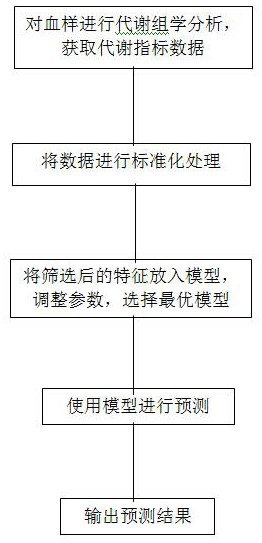Machine learning diabetic retinopathy onset risk prediction method and application
A technology of diabetic retina and machine learning, applied in the fields of instrumentation, informatics, medical informatics, etc., can solve the problems of inconsistent standards, low predictive ability of simple prediction models, and low risk prediction efficiency.
- Summary
- Abstract
- Description
- Claims
- Application Information
AI Technical Summary
Problems solved by technology
Method used
Image
Examples
Embodiment 1
[0038] Such as figure 1As shown, the present invention provides a diabetic retinopathy risk prediction model based on machine learning and metabolic features. The method includes: performing metabolomics detection on the blood samples of the population to be predicted, and obtaining metabolomics characteristic data; preprocessing the collected raw data, using a random forest model to fill in missing values, and performing normalization and discretization on the data Processing; use the preprocessed data to predict using a model based on random forest and support vector machine, and output the prediction result. If the output result is 1, there is a risk of diabetic retinopathy, and if the output result is 0, it does not exist risk of diabetic retinopathy.
[0039] As mentioned above, the embodiments of the present invention provide a method for predicting the risk of diabetic retinopathy based on machine learning algorithms and metabolic characteristics, using techniques main...
Embodiment 2
[0041] See figure 1 , after a patient draws blood in the hospital, the blood sample is analyzed by the staff using a high-throughput analysis instrument to obtain amino acid and carnitine data; the staff fills in the amino acid carnitine data into the preprocessing module and runs the preprocessing program; the preprocessing Put the final data into the model and run the prediction program; output the prediction result. The prediction result of the model is 1 for the metabolic data of a patient, indicating that he has a risk of diabetic retinopathy.
Embodiment 3
[0043] After a subject obtains a metabolic analysis report from a company, he submits the report to the staff, and the staff uses the preprocessing module to preprocess and analyze the data according to the test results. The preprocessed data is used to make predictions using the model. If the result of the prediction output is 0, the subject has no risk of diabetic retinopathy.
PUM
 Login to View More
Login to View More Abstract
Description
Claims
Application Information
 Login to View More
Login to View More - R&D
- Intellectual Property
- Life Sciences
- Materials
- Tech Scout
- Unparalleled Data Quality
- Higher Quality Content
- 60% Fewer Hallucinations
Browse by: Latest US Patents, China's latest patents, Technical Efficacy Thesaurus, Application Domain, Technology Topic, Popular Technical Reports.
© 2025 PatSnap. All rights reserved.Legal|Privacy policy|Modern Slavery Act Transparency Statement|Sitemap|About US| Contact US: help@patsnap.com

